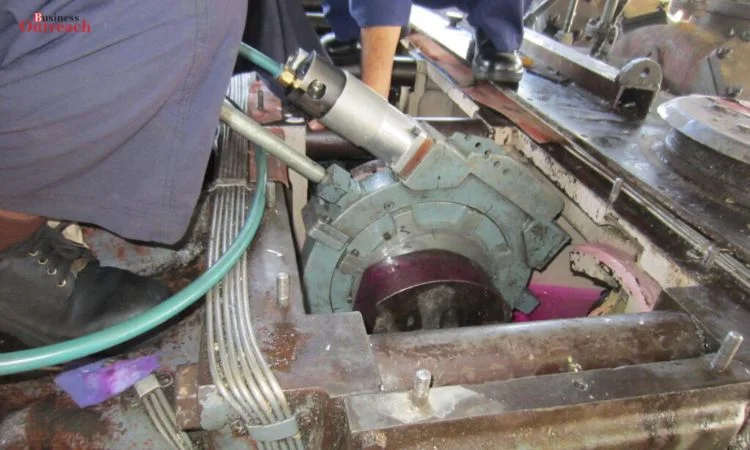The “hearts” of any engine, crankshafts, convert the up-and-down motion provided by the pistons into the rotating energy that propels cars. Worn-out and damaged crankshafts can lead to troublesome faults in the engine and expensive idle time. Conventionally, repairing this issue has required crankshaft disassembling and reassembling the engine. This process is exceedingly complex, time-consuming, and very expensive. The continuous usage of both engines and instruments is not desirable.
Technology makes in-situ grinding faster and cheaper. A crankshaft can be repaired without the removal of an engine. The crankshaft in-situ grinding is feasible. It uses specially designed, engine-connected tools. Re-honing and cleaning restore its surface and its physical perfection to specs.

What is in-situ grinding?
The In-situ Grinding of Crankshaft is an absolutely different process of crankshaft bearing repair within itself in an engine block. The service uses a portable onsite grinding machine with grinding stones and a precision alignment system. The machine removes the material from the crankshaft with high precision to restore it to its size and gloss without removing the engine. This on-site, precise crankshaft repair restores it like new.
However, routine engine maintenance is much more challenging. The engine has to be disassembled and sent to a machining facility, where the crankshaft is removed and subsequently ground by a huge, immobile machine. When the crankshaft is put back, it might become aligned improperly. This might ruin the engine if the repair is not proper.
Key Benefits of In-Situ Crankshaft Grinding
There are primarily some advantages that make in-situ grinding a much better option for crankshaft grinding:
In-situ cutting saves labour costs since it does not require the dismantling or transfer of the engine. It hence speeds up crankshaft maintenance by minimising shipment and labour in fixing it only in the block of the engine. It quickens machinery by reducing its downtime. This eliminates your operating concerns and repair costs.
Time Well Spent: This outweighs the in-situ cutting, which takes longer than the outdated techniques. Most repairs in a day do not disrupt the business much. Traditional crankshaft repair involves removal, followed by work in a machine shop, and then reinstallation; this could take days or even weeks. In-situ cutting accelerates repairs by reusing equipment.
Applications of In-Situ Grinding
In-situ grinding is the need of the-hour for industrial applications.
Lost time is lost money. Ship schedules are an absolute must and are expensive to delay. In-situ crankshaft grinding minimises the downtime and guarantees the timely departure of the ships. Ships require this flexibility when standard repair procedures cannot be followed. In-situ grinding provides an option for repairs at the site so that the marine engine is returned to service seamlessly. The ship can also be on its way at the earliest.
Manufacturing equipment failures can result in delays and are costly. Quick grinding for the repair of cranks in situ obviates downtime and raises the production level. Grinding in situ happens quickly and effortlessly since the crank does not need to be moved from its location. Consequently, the equipment will be returned to work as soon as possible, reducing the loss of production.
Process of In-Situ Grinding
The procedure of in-situ grinding typically happens in the following manner:
Check engine and crankshaft damage ground-in-ability. This is a crucial process in the repair of the engines, given any problems, and it guarantees effectiveness in the repair process.
Preparation of the Engine:
Clean crankshaft grinding: Proper preparation keeps the working space clean and is grinding-friendly. Proper alignment of tools, too, is done by it.
Machine Setup: Levels the in-situ grinding machine using the engine bearings. By now, the machine has to be set for the travel of the crankshaft. It is a necessary pre-requisite to provide for accuracy in grinding.
After proper stone setting, grinding should start. Small amounts of material should be removed and measurements taken precisely. This controlled removal protects and elongates the crankshaft for the exact amount of material removed.
Key equipment and tools used:
In-situ grinding machine: a portable machine that is used exclusively for grinding crankshafts.
Grinding Stones: The selection of onsite grinding stones depends on the crankshaft material and finish. These stones are mounted perfectly on the crankshaft and sweep out all the wheel blasting. This stage is followed by snuffing the crankshaft from impurities and dust particles. It cleans and brutifies the metal, allowing small cracks to appear, which can be removed at the grinding stage.
Micrometres and Gauges: Micrometres and gauges are used to measure and align workpieces during grinding. These instruments keep the crankshaft in good condition and functioning by measuring and placing it properly.
Why choose the MPA Power Project for in-situ grinding?
In-situ grinding is led by the MPA Power Project. Our quality and dependability come from our significant crankshaft repair experience in numerous sectors. Since our knowledge is extensive, we are capable of answering any client’s needs.
Our proficient professionals utilise the latest tools for the best repairs. We provide great service and support during the repair process to satisfy our clients. High-precision, long-lasting repairs can be realised with the utilisation of advanced, high-tech tools and techniques. Your equipment will start up in a short time. Customers’ equipment runs smoothly because of the focus on quality and efficiency.
Case Study: HV Power Station: In-Situ Salvage Scrap Engine Block with Technical Metal Stitching Repair
MPA Power Project successfully conducted a repair to one of their fractured engine blocks at a Caribbean HV Power Plant using the metal stitching patch. Corporate engineers were pretty sure they could repair the power plants in the field due to their knowledge.
Cold Metal Stitching Crack Prevention
Cracks penetrated cylinder head threads. We recommended using our mini tools to fill these holes with an M64 x 3mm thread. Growth of the fracture was prevented in the bolt holes. New EN24T threaded inserts, M64 x 3mm O/d x M56 x 4.5mm I/d, were then fitted into the machined-cut holes. Holes of thread specification were repaired.
Method Combination Power: Fastened Metal Stitching and Grinding
The binding together of two solutions is undoubtedly the strongest aspect of this project.
The in-situ grinding followed metal stitching. This portable grinding machine managed to resize and polish the engine gears to their original proportions. They regained power production due to the successful repair of the MPA Power Project engine block using these processes. While in-situ grinding repaired the bearings for the engines, metal sutures on their part diabetically repaired the cracks. Downtime at HV Power Station was minimised by an innovative method that allowed manufacturing to resume.
Testimonial 1:
A key generator failure at our manufacturing plant set us behind. Disassembling and repairing an engine would have taken weeks, reducing power. Thankfully, the MPA Power Project supplied in-situ grinding. Their crew arrived on schedule and fixed the location in one day! Since their work was superb, our generator worked wonderfully. MPA Power Project in-situ grinding saved time and downtime.
John Smith, Production Manager, ABC Manufacturing
Testimonial 2:
In-service engine failure on the cargo vessel cruise is a worry for any skipper. Recent crankshaft problems put our delivery schedule at risk. Fortunately, MPA Power Project offered ship-board grinding. Their technicians were efficient and quick, with minimal disruption to our operations. In-situ grinding got us back on track in record time, and we were able to deliver our cargo on schedule. We recommend MPA Power Project’s innovative in-situ marine engine repair solutions.
Captain Jane Doe, MV Ocean Spirit
Commitment to Quality and Customer Satisfaction
Quality and customer satisfaction reflect what is entailed in the case study of the MPA Power Project. The MPA Power Project staff is skilled and equipped with relevant knowledge and tools for the repair service of complex engines like HV power plants. The MPA Power Project effects difficult repairs within the shortest time and to the best standards.
MPA Power Projects prides itself on communication and troubleshooting. More importantly, expectations are set up that keeps the consumer well informed and involved, hence creating a helpful atmosphere. The MPA Power Project Team will keep the customer informed from the initial engine check all the way through to the final inspection after upgrades.
Conclusion
The in-situ grinding facility, till today, rectifies crankshafts in various industries. This very act of innovation economises money and time by not disassembling and assembling the engine. In-situ grinding provides quality-assured repairs with minimal material loss through its precision control, leaving a smooth, wear-resistant coating on the crankshaft that remains intact.
In-situ grinding can easily and quickly repair the naval engine, industrial machine, and large power plant-engine crankshaft. Do not stop work due to a broken axle. Speak with the MPA Power Project now! Our technicians are well-trained; with the latest equipment and expertise, we shall be able to do your bidding.















